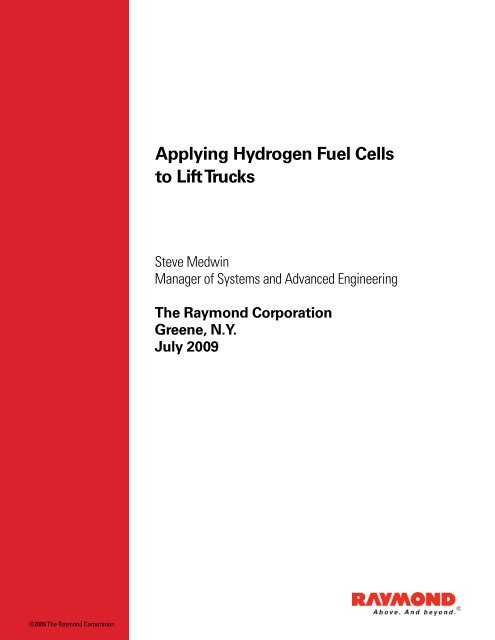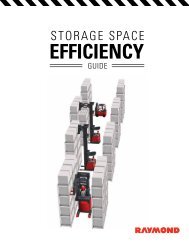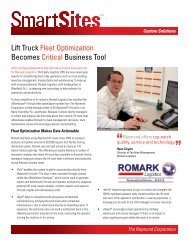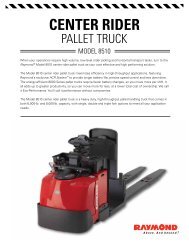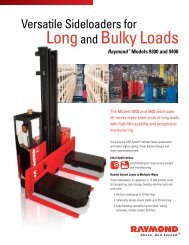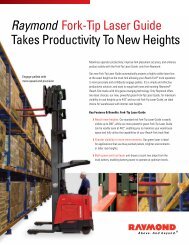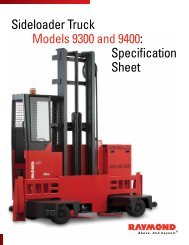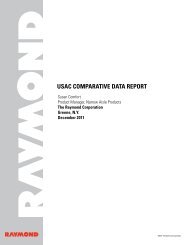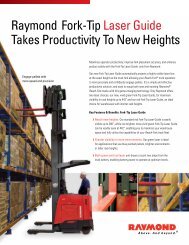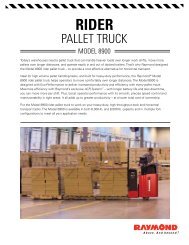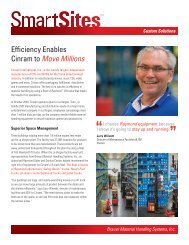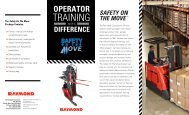Applying Hydrogen Fuel Cells to Lift Trucks - Raymond Corporation
Applying Hydrogen Fuel Cells to Lift Trucks - Raymond Corporation
Applying Hydrogen Fuel Cells to Lift Trucks - Raymond Corporation
- No tags were found...
You also want an ePaper? Increase the reach of your titles
YUMPU automatically turns print PDFs into web optimized ePapers that Google loves.
<strong>Applying</strong> <strong>Hydrogen</strong> <strong>Fuel</strong> <strong>Cells</strong><strong>to</strong> <strong>Lift</strong> <strong>Trucks</strong>Steve MedwinManager of Systems and Advanced EngineeringThe <strong>Raymond</strong> <strong>Corporation</strong>Greene, N.Y.July 2009©2009 The <strong>Raymond</strong> <strong>Corporation</strong>
Table of ContentsIntroduction............................................................................................................................................3<strong>Raymond</strong>’s <strong>Fuel</strong> Cell Research...............................................................................................................3<strong>Fuel</strong> Cell Benefits...................................................................................................................................3Evolutionary Application .......................................................................................................................5Using <strong>Fuel</strong> <strong>Cells</strong> Today...........................................................................................................................6Return on Investment.............................................................................................................................7Considerations for Getting Started .......................................................................................................8Ongoing Evaluation................................................................................................................................8About the Author....................................................................................................................................9©2009 The <strong>Raymond</strong> <strong>Corporation</strong> 2
IntroductionThe <strong>Raymond</strong> <strong>Corporation</strong> is continuing its his<strong>to</strong>ry of innovation by investigatingand evaluating the application of hydrogen fuel cells <strong>to</strong> lift trucks. Based onits research, there appears <strong>to</strong> be significant potential <strong>to</strong> improve warehouseproductivity if fuel cells are used in high-throughput warehouse applications.Now that hydrogen fuel cells are commercially available, it is important <strong>to</strong>understand that switching <strong>to</strong> fuel cells can have an impact on the operation of alift truck originally designed <strong>to</strong> use lead-acid batteries. In addition, case-by-caseconsiderations must be made <strong>to</strong> determine whether a facility will benefit fromconverting its lift truck fleet <strong>to</strong> use hydrogen power.<strong>Raymond</strong>’s <strong>Fuel</strong> Cell Research<strong>Raymond</strong> is a global provider of electric lift truck innovations, deliveringadvanced, reliable, cost-effective lift trucks and solutions that make itscus<strong>to</strong>mers more productive. <strong>Raymond</strong> offers a full line of electric lift trucks. <strong>Raymond</strong> ® branded products are produced at three differentfac<strong>to</strong>ries, each of which specializes in the manufacture of distinct product lines.<strong>Raymond</strong> started reviewing the use of fuel cells in material handling early in 2004, primarily because cus<strong>to</strong>mers were inquiring aboutthis technology. <strong>Raymond</strong> evaluated fuel cell suppliers and continues <strong>to</strong> actively work with all the major companies <strong>to</strong> gain experiencewith the technology.In 2007, <strong>Raymond</strong> developed a research program with a contract from the New York State Energy Research and DevelopmentAuthority (NYSERDA) and the New York Power Authority (NYPA) <strong>to</strong> perform a study on the performance of hydrogen fuel cells in lifttrucks and the use of indoor hydrogen fueling stations in a real-life manufacturing environment. Early findings in the study indicatedthat, in comparison with battery-powered lift trucks, hydrogen fuel cell-powered lift trucks maintain comparable performance whilesignificantly reducing refueling time.In 2008, <strong>Raymond</strong> signed a joint development agreement with a major fuel cell developer <strong>to</strong> begin research on designs for fuel cellpoweredlift trucks. The goal of this partnership is <strong>to</strong> develop a pro<strong>to</strong>type using the next generation of fuel cell technology <strong>to</strong> power<strong>Raymond</strong> lift trucks.<strong>Fuel</strong> Cell BenefitsThe basic question remains: What are the benefits <strong>to</strong> using a fuel cell rather than a lead-acid battery? Lead-acid batteries are areliable, familiar technology that is readily available from multiple suppliers. In the design of a lift truck, batteries also provide neededcounterweight.©2009 The <strong>Raymond</strong> <strong>Corporation</strong> 3
However, lead-acid batteries have limited range. At most, they will last one shift in a high-throughput warehouse. The rechargingcycle is long, typically taking one shift <strong>to</strong> charge and then another shift <strong>to</strong> cool down. For a three-shift operation, three batteries and acharger may be needed, as well as room <strong>to</strong> s<strong>to</strong>re and maintain them. Battery voltage drops as the battery discharges, which leads <strong>to</strong>reduced truck performance. Finally, special care is needed when disposing of batteries due <strong>to</strong> their lead and acid content.<strong>Raymond</strong> truck withhydrogen fuel cellDepends ontank size100%Truck PreformanceCompeti<strong>to</strong>r’s DC truckwith lead acid battery<strong>Raymond</strong> AC truckwith lead acid batteryHours <strong>to</strong> DischargeFullydischargedDuring the first two years of its research program, <strong>Raymond</strong> uncovered several assessments and benefits of hydrogen fuel cell-poweredlift trucks, compared with battery-powered lift trucks:1.2.3.Maximum travel and lift speeds of hydrogen fuel cell-powered trucks are equivalent <strong>to</strong> that of battery-powered lift trucks.Refueling a fuel cell truck at an indoor hydrogen refueling station takes only a couple of minutes compared with the up <strong>to</strong> 20minutes it takes <strong>to</strong> remove and replace a battery from the same truck model.In <strong>to</strong>day’s electric lift truck designs, the battery acts as part of the counterweight. <strong>Hydrogen</strong> fuel cell components do notweigh the same as heavy lead-acid batteries, so additional weight must be added <strong>to</strong> the fuel cell unit. This weight must bedistributed within the fuel cell system so the center of gravity is the same as that of the battery it replaces. Future lift truckswill likely have the fuel cells wholly incorporated in<strong>to</strong> the design of the trucks <strong>to</strong> address these issues.<strong>Hydrogen</strong> fuel cells offer higher productivity simply because they can be rapidly refueled by the opera<strong>to</strong>rs, eliminating the need <strong>to</strong>change, s<strong>to</strong>re and maintain batteries. In addition, fuel cells produce constant voltage. There is no voltage drop <strong>to</strong>wards the end of ashift like there is with batteries, so productivity does not decline. Unless the fuel runs out, the vehicle experiences no performance©2009 The <strong>Raymond</strong> <strong>Corporation</strong> 4
degradation — like a car and its gas tank. And hydrogen is environmentally clean: the only byproducts from a fuel cell are water andheat.Although fuel cell-powered lift trucks are not yet rated for the low temperatures of freezers, fuel cells could perform better thanbattery-operated lift trucks in cold s<strong>to</strong>rage environments. When lift trucks with lead-acid batteries are driven in freezers, the range andperformance of the truck is reduced because the cold temperatures significantly reduce battery run time between charges. Performanceis maintained in a lift truck with a fuel cell because the voltage and current remain the same at cold temperatures.Lead-acid BatteriesReliable, familiar technologyProvide needed counterweight in lift truck designTypically last one shift in a warehouse; takes up <strong>to</strong> 20 minutes <strong>to</strong>changeRecharging cycle is long: one shift <strong>to</strong> charge and one shift <strong>to</strong> cooldownMultiple batteries and chargers required for multishift operations;s<strong>to</strong>rage space is necessary<strong>Lift</strong> truck performance drops as battery discharges or in coldtemperatures<strong>Hydrogen</strong> <strong>Fuel</strong> <strong>Cells</strong>New technology; additional testing in progressAdditional weight must be added <strong>to</strong> the fuel cell unit <strong>to</strong> maintaincounterweightCan be refueled in minutes during a shiftNo recharging requiredNo batteries, chargers or battery room requiredNo performance degradation as hydrogen depletes or in coldtemperaturesEvolutionary ApplicationThere is a three-stage evolution in the application of fuel cells <strong>to</strong> lift trucks, which affects lift truck design.Battery replacement.In this step, the lead-acid battery is removed and replaced with a fuel cell system of the same size, weight and energy capacity.The truck operates as before and does not know it is being powered by a fuel cell. A slightly more complex version of the batteryreplacement step involves adding a field-installable fuel cell adapter kit. This kit might include additional counterweight or aFigure 1:Battery ReplacementFigure 2:Existing PlatformModificationFigure 3:Concept Design©2009 The <strong>Raymond</strong> <strong>Corporation</strong> 5
communication cable between the truck and the fuel cell. While the complete battery replacement can be developed by a fuel cellsupplier, development of the adapter kit requires cooperation between the fuel cell supplier and lift truck manufacturer.Existing platform modification.In this case, an existing truck design is used, with the fuel cell components distributed in an optimum way around the truck. The newtruck would be available with a fuel cell option. Development of this truck would require very close cooperation between the truckmanufacturer and the fuel cell supplier.Clean sheet design.Ultimately, a new truck is designed from the ground up <strong>to</strong> take full advantage of the modular nature of the fuel cell system. The fuel cellwould be completely integrated in<strong>to</strong> the truck and could not use a conventional battery. The truck manufacturer would do most of thedevelopment while working closely with a fuel cell supplier.Using <strong>Fuel</strong> <strong>Cells</strong> Today<strong>Raymond</strong> does not build fuels cells, but works closely with major fuel cell suppliers <strong>to</strong> ensure that fuel cell technology is compatiblewith <strong>Raymond</strong> trucks now and in the future. <strong>Raymond</strong>’s intention is <strong>to</strong> provide cus<strong>to</strong>mers the widest range of options and be prepared<strong>to</strong> meet their fuel cell needs.Because the evolution of hydrogen fuel cell-powered lift trucks requires close cooperation between fuel cell suppliers and lift truckmanufacturers, <strong>Raymond</strong> has been actively involved in the Industrial Truck Association’s Energy S<strong>to</strong>rage System (ESS) committee <strong>to</strong>facilitate discussions between lift truck manufacturers and ESS manufacturers. This discussion ensures fuel cells or other ESSs — suchas lithium-ion batteries or supercapaci<strong>to</strong>rs — meet lift truck requirements.These criteria can help ensure the ESS meets the minimum lift truckrequirements and operates as an effective lead-acid battery replacement. Byhelping <strong>to</strong> define these criteria, lift truck manufacturers can make it easierfor fuel cell manufacturers <strong>to</strong> design a power source that integrates with<strong>to</strong>day’s lift trucks.Future lift trucks may fully encompass the fuel cell in the design, butaccording <strong>to</strong> the preliminary work of the ESS committee, <strong>to</strong>day’s lift trucksrequire the fuel cell <strong>to</strong> emulate batteries in five key areas:Size.In <strong>to</strong>day’s lift trucks, the hydrogen fuel cell needs <strong>to</strong> fit in the same spaceoccupied by the battery. Defining the available space for the hydrogen fuel cell, which varies in different types of lift trucks, ensures thefuel cell will fit in a lift truck designed for a lead-acid battery.Weight.When hydrogen fuel cells are used as battery replacements, they must meet the same minimum and maximum weight requirementslisted on the lift truck’s specification tag for batteries. Meeting the weight requirement is a critical fac<strong>to</strong>r in ensuring the stability of thelift truck. <strong>Hydrogen</strong> fuel cells can be significantly lighter than lead-acid batteries, so fuel cell manufacturers typically add steel plates <strong>to</strong>their fuel cell units <strong>to</strong> make up for the weight required.©2009 The <strong>Raymond</strong> <strong>Corporation</strong> 6
Center of gravity.In a lift truck powered by a lead-acid battery, the center of gravity of the battery is the geometric center of the battery box. In a fuel cellunit that is being used as a battery replacement, the unit incorporates many separate components, including a hydrogen tank, a fuelcell stack and steel counterweight added <strong>to</strong> meet the minimum weight requirements. Balancing the placement of these components isnecessary <strong>to</strong> ensure the proper center of gravity. <strong>Lift</strong> truck manufacturers need <strong>to</strong> perform tests or analysis on each lift truck they intend<strong>to</strong> use or approve for use with a fuel cell <strong>to</strong> determine the exact <strong>to</strong>lerance for where the center of gravity can be located.Power delivered.Different types of lift trucks are designed for different applications andcapabilities, and varying amounts of power are required <strong>to</strong> accomplish thesetasks. Specifying the current and voltage delivery requirements of the lifttruck at various time durations ensures the lift truck receives the power froma hydrogen fuel cell that is necessary <strong>to</strong> maintain acceptable performance invarious applications.Power absorbed.When electric lift truck brakes are applied or forks are lowered, they can createregenerative energy. This energy must be absorbed by the energy source, andhydrogen fuel cells are not able <strong>to</strong> recapture energy like lead-acid batteries.Therefore, all hydrogen fuel cell units are actually hybrids and contain a batteryor supercapaci<strong>to</strong>rs. It is necessary <strong>to</strong> define how much regenerative energy eachlift truck creates that needs <strong>to</strong> be absorbed by the battery or supercapaci<strong>to</strong>rs.As with power delivered, lift truck manufacturers can specify the maximum andminimum current and voltage generated by the lift truck as it brakes from variousspeeds or lowers forks with different amounts of weight for different timedurations. If the fuel cell unit is unable <strong>to</strong> absorb the energy generated, then afault code would be generated that could potentially disable the lift truck.Return on InvestmentReturn on investment for facilities that switch <strong>to</strong> hydrogen fuel cells depends on many variables specific <strong>to</strong> each facility’s applications.Typically, the larger the fleet, the quicker the payback will be. Cost savings can come from several areas. Battery changes, which maytake 15 or 20 minutes each, are not necessary in a fuel cell fleet. A fuel cell truck may run up <strong>to</strong> three times longer than a batterypoweredtruck, and refueling takes less than 5 minutes. Labor savings and productivity increases multiplied across a large fleet runningtwo or three shifts can be hundreds of hours per month. While fuel cell users need <strong>to</strong> buy hydrogen, electricity use will decreasebecause no batteries are being charged. Cost per kWh may decrease as well because peak electric usage is reduced.An investment in fuel cells and the required hydrogen fueling infrastructure can be justified in lift truck fleets of approximately 40 ormore trucks with a two-shift operation. Fleets of this size will typically see a return that justifies the investment. Individual warehousesand distribution centers need <strong>to</strong> conduct a detailed financial analysis, including the local cost of hydrogen, <strong>to</strong> determine whetherswitching <strong>to</strong> hydrogen fuel cell-powered lift trucks is appropriate for their operation. A lift truck manufacturer or dealer can assist inconducting a thorough investigation and evaluation of fuel cells.©2009 The <strong>Raymond</strong> <strong>Corporation</strong> 7
An investment tax credit (ITC) is available from the U.S. federal government <strong>to</strong> those who purchase fuel cell technology. The ITCprovides business property owners with a credit of 30 percent of the cost of the fuel cell units or $3,000 per kW of capacity, whicheveris lower. The credit has been extended <strong>to</strong> 2016 and has a significant impact on the financial viability of a fuel cell project. Also, atax credit is available for the purchase and installation of the hydrogen infrastructure for 30 percent of the cost of the project, up<strong>to</strong> $200,000. Some states also provide tax credits for fuel cell purchases. Companies should check with their own tax advisors forinformation on the potential financial benefits of taking this tax credit.Considerations for Getting StartedThe first step in choosing <strong>to</strong> make the switch <strong>to</strong> hydrogen fuel cell-powered lift trucks is <strong>to</strong> evaluate the facility’s interest in andcommitment <strong>to</strong> new technologies. The facility must thoroughly evaluate the cost of implementation, potential cost reductions andproductivity gains that can be realized by using hydrogen power.Companies choosing hydrogen fuel cell-powered lift trucks will need <strong>to</strong> work with multiple vendors <strong>to</strong> supply fuel cells, hydrogen andhydrogen s<strong>to</strong>rage systems. In addition, no single supplier currently provides fuel cells for Class I, II and III electric lift trucks.Facilities also will need <strong>to</strong> determine how hydrogen will be delivered and s<strong>to</strong>red on site, or if the hydrogen will be generated on site.With either method, a hydrogen infrastructure and indoor refueling system will need <strong>to</strong> be installed.The scope and scale of the project must be determined <strong>to</strong> develop a plan for how fuel cell-powered lift trucks will be implemented inthe warehouse or distribution center. Some facilities choose <strong>to</strong> begin with a pilot project using a small subset of their lift truck fleet. Inother cases, facilities choose <strong>to</strong> switch their entire fleet <strong>to</strong> hydrogen power. In either case, it is necessary <strong>to</strong> ensure the lift trucks areproperly prepared for fuel cells in order <strong>to</strong> make the switch from batteries <strong>to</strong> fuel cells as smooth as possible.Ongoing EvaluationCurrently, <strong>Raymond</strong> is continuing <strong>to</strong> test, moni<strong>to</strong>r and analyze many other areas of fuel cell research, including:>>>>>>>>Operation details of the hydrogen infrastructure and refueling<strong>Hydrogen</strong> consumption and refueling frequencyLonger-term reliability, maintenance and repairability of fuel cellsystemsVoltage delivered by a fuel cell and how it compares with thespecifications for all the electrical components and options on a lifttruckToday, early industry adopters are using fuel cell technology in their facilities.However, the areas for ongoing evaluation, among others, must be analyzedbefore the material handling industry adopts a widespread use of hydrogen fuelcell-powered lift trucks.Material handling trade associations, such as the Industrial Truck Association,are reviewing the technology with its Energy S<strong>to</strong>rage Systems group. NYSERDA©2009 The <strong>Raymond</strong> <strong>Corporation</strong> 8
has created a <strong>Fuel</strong> Cell Advancement team <strong>to</strong> support New York state companies in the development of fuel cell systems and projects.The US Department of Energy (http://www.hydrogen.energy.gov) and The National <strong>Hydrogen</strong> Association (www.hydrogenassociation.org) also are promoting fuel cell research, development and deployment. Information on hydrogen initiatives, listed alphabetically andby state, can be found on the Web site www.hydrogenassociation.org/policy/initiatives.asp.Through its ongoing work with fuel cells, <strong>Raymond</strong> is adding <strong>to</strong> its rich his<strong>to</strong>ry of cus<strong>to</strong>mer-centric innovation and continuing <strong>to</strong> be atthe forefront of this alternative energy source for electric lift trucks.About the AuthorSteve Medwin is manager of systems and advanced engineering at The <strong>Raymond</strong> <strong>Corporation</strong>. Since 2004, he has been evaluatingthe application of fuel cell technology <strong>to</strong> the material handling business. Before joining <strong>Raymond</strong>, Medwin spent 20 years in researchand development at DuPont. He holds nine U.S. patents and is a member of the UL 2267 Standards Technical Panel for <strong>Fuel</strong> Cell PowerSystems for Industrial Electric <strong>Trucks</strong> and chairman of the new Energy S<strong>to</strong>rage Systems committee of the ITA.Medwin received his bachelor’s degree in mechanical engineering from Cornell University in Ithaca, N.Y., and his master’s degree inmechanical engineering from the University of Pennsylvania in Philadelphia. He also has completed the Executive MBA program atBingham<strong>to</strong>n University in Bingham<strong>to</strong>n, N.Y.For additional information about The <strong>Raymond</strong> <strong>Corporation</strong> or <strong>to</strong> locate a <strong>Raymond</strong> dealer, visit the company Web site at www.raymondcorp.com orcall (800) 235-7200. Above. And beyond. and <strong>Raymond</strong> are U.S. trademarks of The <strong>Raymond</strong> <strong>Corporation</strong>.All other trademarks are the property of their respective companies.©2009 The <strong>Raymond</strong> <strong>Corporation</strong> 9


